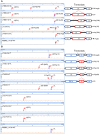Minigene Splicing Assays Identify 12 Spliceogenic Variants of BRCA2 Exons 14 and 15
- PMID: 31191615
- PMCID: PMC6546720
- DOI: 10.3389/fgene.2019.00503
Minigene Splicing Assays Identify 12 Spliceogenic Variants of BRCA2 Exons 14 and 15
Abstract
A relevant fraction of BRCA2 variants is associated with splicing alterations and with an increased risk of hereditary breast and ovarian cancer (HBOC). In this work, we have carried out a thorough study of variants from BRCA2 exons 14 and 15 reported at mutation databases. A total of 294 variants from exons 14 and 15 and flanking intronic sequences were analyzed with the online splicing tools NNSplice and Human Splicing Finder. Fifty-three out of these 294 variants were selected as candidate splicing variants. All variants but one, were introduced into the minigene MGBR2_ex14-20 (with exons 14-20) by site-directed mutagenesis and assayed in MCF-7 cells. Twelve of the remaining 52 variants (23.1%) impaired splicing at different degrees, yielding from 5 to 100% of aberrant transcripts. Nine variants affected the natural acceptor or donor sites of both exons and three affected putative enhancers or silencers. Fluorescent capillary electrophoresis revealed at least 10 different anomalous transcripts: (E14q5), Δ (E14p10), Δ(E14p246), Δ(E14q256), Δ(E14), Δ(E15p12), Δ(E15p13), Δ(E15p83), Δ(E15) and a 942-nt fragment of unknown structure. All transcripts, except for Δ(E14q256) and Δ(E15p12), are expected to truncate the BRCA2 protein. Nine variants induced severe splicing aberrations with more than 90% of abnormal transcripts. Thus, according to the guidelines of the American College of Medical Genetics and Genomics, eight variants should be classified as pathogenic (c.7008-2A > T, c.7008-1G > A, c.7435+1G > C, c.7436-2A > T, c.7436-2A > G, c.7617+1G > A, c.7617+1G > T, and c.7617+2T > G), one as likely pathogenic (c.7008-3C > G) and three remain as variants of uncertain clinical significance or VUS (c.7177A > G, c.7447A > G and c.7501C > T). In conclusion, functional assays by minigenes constitute a valuable strategy to primarily check the splicing impact of DNA variants and their clinical interpretation. While bioinformatics predictions of splice site variants were accurate, those of enhancer or silencer variants were poor (only 3/23 spliceogenic variants) which showed weak impacts on splicing (∼5-16% of aberrant isoforms). So, the Exonic Splicing Enhancer and Silencer (ESE and ESS, respectively) prediction algorithms require further improvement.
Keywords: BRCA2; DNA variants; breast cancer; hybrid minigenes; splicing.
Figures



Similar articles
-
Functional classification of DNA variants by hybrid minigenes: Identification of 30 spliceogenic variants of BRCA2 exons 17 and 18.PLoS Genet. 2017 Mar 24;13(3):e1006691. doi: 10.1371/journal.pgen.1006691. eCollection 2017 Mar. PLoS Genet. 2017. PMID: 28339459 Free PMC article.
-
Mis-splicing in breast cancer: identification of pathogenic BRCA2 variants by systematic minigene assays.J Pathol. 2019 Aug;248(4):409-420. doi: 10.1002/path.5268. Epub 2019 Apr 23. J Pathol. 2019. PMID: 30883759
-
Identification of Eight Spliceogenic Variants in BRCA2 Exon 16 by Minigene Assays.Front Genet. 2018 May 24;9:188. doi: 10.3389/fgene.2018.00188. eCollection 2018. Front Genet. 2018. PMID: 29881398 Free PMC article.
-
Splicing predictions, minigene analyses, and ACMG-AMP clinical classification of 42 germline PALB2 splice-site variants.J Pathol. 2022 Mar;256(3):321-334. doi: 10.1002/path.5839. Epub 2021 Dec 28. J Pathol. 2022. PMID: 34846068 Free PMC article.
-
Comprehensive splicing analysis of the alternatively spliced CHEK2 exons 8 and 10 reveals three enhancer/silencer-rich regions and 38 spliceogenic variants.J Pathol. 2024 Apr;262(4):395-409. doi: 10.1002/path.6243. Epub 2024 Feb 9. J Pathol. 2024. PMID: 38332730
Cited by
-
Case Report: A Novel Variant c.2262+3A>T of the SCN5A Gene Results in Intron Retention Associated With Incessant Ventricular Tachycardias.Front Med (Lausanne). 2021 Aug 4;8:659119. doi: 10.3389/fmed.2021.659119. eCollection 2021. Front Med (Lausanne). 2021. PMID: 34422849 Free PMC article.
-
Identification of a new COQ4 spliceogenic variant causing severe primary coenzyme Q deficiency.Mol Genet Metab Rep. 2024 Dec 14;42:101176. doi: 10.1016/j.ymgmr.2024.101176. eCollection 2025 Mar. Mol Genet Metab Rep. 2024. PMID: 39759098 Free PMC article.
-
VIsoQLR: an interactive tool for the detection, quantification and fine-tuning of isoforms in selected genes using long-read sequencing.Hum Genet. 2023 Apr;142(4):495-506. doi: 10.1007/s00439-023-02539-z. Epub 2023 Mar 7. Hum Genet. 2023. PMID: 36881176 Free PMC article.
-
RAD51D Aberrant Splicing in Breast Cancer: Identification of Splicing Regulatory Elements and Minigene-Based Evaluation of 53 DNA Variants.Cancers (Basel). 2021 Jun 7;13(11):2845. doi: 10.3390/cancers13112845. Cancers (Basel). 2021. PMID: 34200360 Free PMC article.
-
Minigene Splicing Assays Identify 20 Spliceogenic Variants of the Breast/Ovarian Cancer Susceptibility Gene RAD51C.Cancers (Basel). 2022 Jun 15;14(12):2960. doi: 10.3390/cancers14122960. Cancers (Basel). 2022. PMID: 35740625 Free PMC article.
References
LinkOut - more resources
Full Text Sources
Research Materials
Miscellaneous

